- Bernard Preston homepage
- Greens
- Fennel and Radish Salad
Fennel and radish salad
Fennel and radish salad on a bed of lettuce makes a scrumptious side-dish.
Salads without lettuce are in vogue and I'm half-way sympathetic; fresh crisp greens are so difficult to obtain unless you grow them in your own garden.
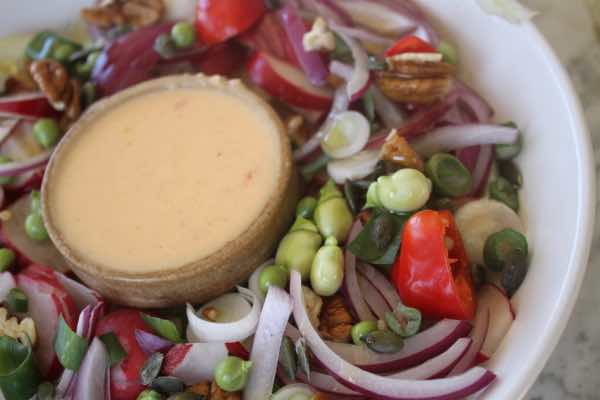
- One fennel-bulb
- A dozen radishes
- Quarter of a red-onion
- Two spring-onions
- A handful of baby green legumes; broad beans and peas
For the dressing you need
- Quarter of a cup of joghurt
- Two tablespoons of olive-oil
- One jalapeno, or half a chili
- Half a whole lemon or lime peeled, using some of the zest
- A slosh of water
- Salt and black-pepper to taste
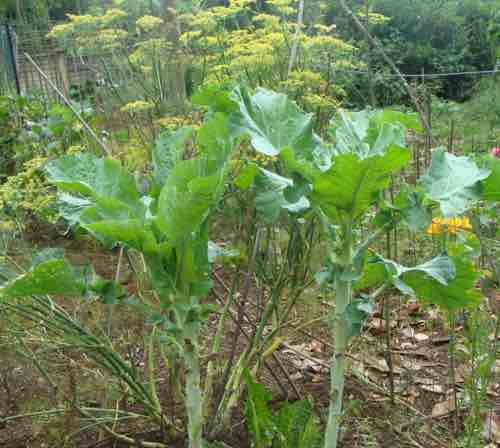 Fennel in flower with kale in the foreground.
Fennel in flower with kale in the foreground.This page was last updated by Bernard Preston on 5th April, 2023.
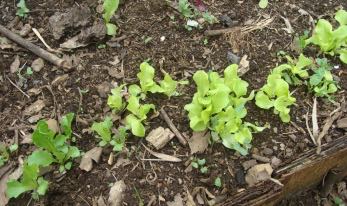
We try to make sure that every month of the year we've got a row of mixed, tiny lettuce-seedlings like this; fresh from the garden they form the basis of every good salad, rich in nutrients.
The iceberg doesn't count; it is not a green and, though loved by the world, as far as I am concerned has little virtue. No wonder so many folk hate a lettuce-salad.
Fennel is one of those mystical herbs that most of us have never seen or tasted, yet it's not difficult to grow. It does need plenty of water; and seeds itself like coriander every spring.
It's actually related to the carrot-family, as you can see from the fronds of yellow flowers; and it is crunchy rather like celery, though sweeter. In fact you will notice if you are a gardener that the blooms look very like dill and cilantro.
Fennel is rich in many anti-tumour flavonoids; they also reduce inflammation.
Names like quercitin, kaempferol and rutin that you may have heard of characterise fennel; and anethole that probably draws a blank. Google them if you're interested.
My point is that to escape getting neoplasms it's not enough simply to avoid smoking and get enough fibre to stop constipation; and avoiding hormone-replacement therapy.
We need to be enjoying these vital phytonutrients on a daily basis, and the only way to do that is to eat a widely varied-diet; one that might include a fennel and radish salad periodically.
Radishes
Radish is almost certainly the easiest salad vegetable to grow; it is where I begin with my grandchildren. Pop a row of seeds into the ground, cover them and within a month you will all be munching one of their favourites.
I love the spicy bite that they give to any otherwise bland-salad and they too are rich in a heap of different phytonutrients.
Every salad needs a dressing and today, rather than our trusty hummus, I am going to suggest a creamy yoghurt sauce with dill and of course lemon-pulp. I almost never recommend just the strained juice since more than half the nutrients are lost.
Protein
Nevertheless to give our fennel and radish salad some protein, we are going to throw in a handful of legumes; young green ones are best. Baby broad beans or peas are delicious. You could use cubes of feta-cheese instead.
Every salad worthy of the name must have a very substantial drizzle of extra virgin olive oil; there you'll find even more anti-inflammatory phytochemicals to ease the pain in your angry muscles and joints, not to mention the blood vessels and organs.
So let's cut the chat and get to our fennel and radish salad.
Fennel and radish salad
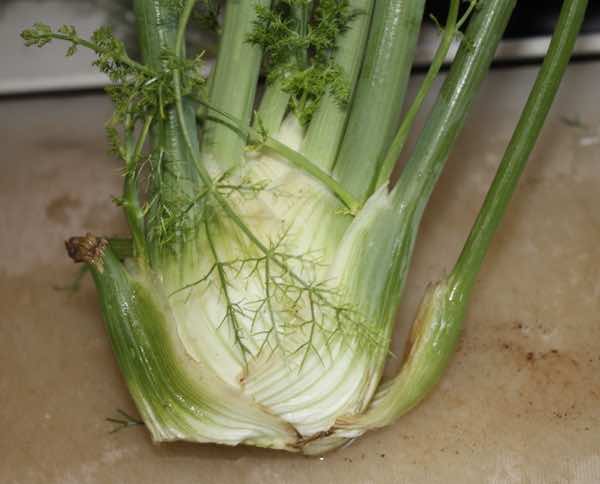
Fennel and radish salad gives you half the coloured-foods you need every day in one dish.
Sorry but I have to put in one more word; seven coloured foods every day will reduce your all-cause of death by a massive 35 percent. You don't like pain and visits to doctors, I presume; and do want to live to a feisty eighty with all your marbles intact, right?
If you're very lucky to find a fennel-bulb at the greengrocer, well and good but it is unlikely, so venture down the garden and dig one from your veggie patch. Pick a good handful of dill and a dozen radishes; and a jalapeno or peppadew. Add a dozen tender leaves of your favourite lettuce to the basket; preferably several different kinds.
Romaine and butter-lettuce are our favourites. Wash everything thoroughly. In your favourite salad bowl make a bed of fresh, crisp lettuce-leaves.
- Cover the lettuce with finely sliced-fennel, onions and radishes; or tomato.
- Sprinkle a handful of baby green beans or peas.
- Drizzle the whole with olive-oil.
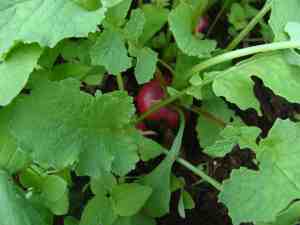
Using a stick-blender, mix the yoghurt, olive oil and lemon pulp; and a little of the zest, a handful of dill and a slosh of spring water. Add the sea salt and freshly-ground black pepper.
You could immediately pour the yoghurt dressing over the salads, but I prefer to allow your guests to add their own; it looks very appetising in a small bowl or crystal-jug.
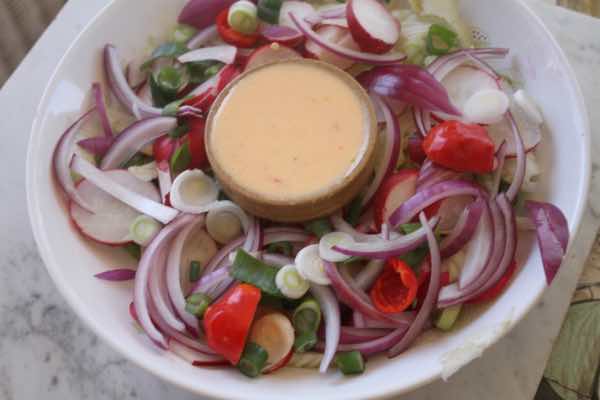
Easy lunch recipes
This is one of our best easy-lunch recipes; if you have the fennel on hand. Otherwise think of another dish; could you replace it with celery? Of course.
Cooking chickpeas
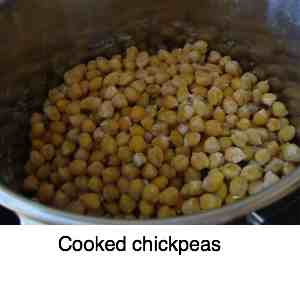
There are a number of reasons I recommend cooking chickpeas yourself; the cost is one quarter for starters. They go magnificently with any dish like your fennel and radish salad, adding a valuable source of vegetable protein; and the richest source of pyridoxine, an essential B-vitamin[1].
But you really do need a pressure-cooker; for me it is one of the most important kitchen appliances. They save you time and money.
The longevity diet stresses plenty of whole grains and legumes; don't you too want to live to a strong and vital ninety with all your marbles intact?
Part of the deal is the magnesium for your heart.
With solar pressure cooking the cost is zero but the time required for steaming chickpeas is one third. Freeze what's left over in cup-sized packets.
1. Vitamin B6 @ ODS
When browsing use right click and "Open Link in New Tab" or you may get a bad gateway signal.
Newsletter
Our newsletter is entitled "create a cyan zone" at your home, preserving both yourself and Mother Earth for future generations; and the family too, of course. We promise not to spam you with daily emails promoting various products. You may get an occasional nudge to buy one of my books.
Here are the back issues.
- Lifestyle and ideal body weight
- What are ultra-processed foods?
- Investing in long-term health
- Diseases from plastic exposure
- Intensive lifestyle management for obesity has limited value
- A world largely devoid of Parkinson's Disease
- The impact of friendly bacteria in the tum on the prevention of cancer
- There's a hole in the bucket
- Everyone is talking about weight loss drugs
- Pull the sweet tooth
- If you suffer from heartburn plant a susu
- Refined maize meal and stunting
- Should agriculture and industry get priority for water and electricity?
- Nature is calling
- Mill your own flour
- Bake your own sourdough bread
- Microplastics from our water
- Alternative types of water storage
- Wear your clothes out
- Comfort foods
- Create a bee-friendly environment
- Go to bed slightly hungry
- Keep bees
- Blue zone folk are religious
- Reduce plastic waste
- Family is important
- What can go in compost?
- Grow broad beans for longevity
- Harvest and store sunshine
- Blue zone exercise
- Harvest and store your rainwater
- Create a cyan zone at your home
Did you find this page interesting? How about forwarding it to a friendly book or food junkie? Better still, a social media tick would help.
- Bernard Preston homepage
- Greens
- Fennel and Radish Salad
Address:
56 Groenekloof Rd,
Hilton, KZN
South Africa
Website:
https://www.bernard-preston.com